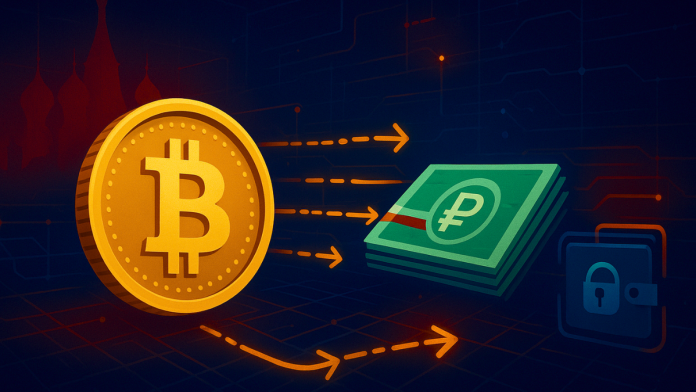A Kremlin-backed cryptocurrency has moved more than $6 billion since August, even after parts of its network were blacklisted by the United States. This shows that efforts to block Russia’s financial activities are facing serious challenges.
The coin, known as A7A5, is a type of digital money called a stablecoin. Stablecoins are designed to hold a steady value, often linked to real-world currencies. In this case, each A7A5 token is backed by the Russian ruble, making it a tool for cross-border payments and trade.
When the United States sanctioned Grinex, a Kyrgyzstan-based exchange, operators of A7A5 acted quickly. They deleted funds from the wallets connected to Grinex and created new ones. This clever move made the money appear “clean” again, allowing it to continue circulating despite the sanctions.
This process shows that cryptocurrencies can be used to bypass sanctions in ways that traditional banking cannot. By deleting and recreating tokens, A7A5 effectively reset the history of the funds, making them harder to trace or block.
The Financial Times reports that 33.8 billion tokens, worth around $405 million, were wiped from the old wallets. The same amount was then recreated in a new wallet, known as TNpJj. Since then, this wallet has been involved in $6.1 billion worth of transactions, according to analysis of blockchain activity.
How the System Works
Unlike regular money transfers, A7A5 uses a special method that removes the transaction history of tokens before placing them in a new wallet. The old tokens are labeled as “dirtyShares,” while the newly minted tokens have no link to the previous wallets. This makes it extremely challenging for authorities to track or freeze the money.
The A7A5 system operates on Ethereum and Tron blockchains, which are public digital ledgers where transactions can be recorded and verified. The network is designed to function like a traditional bank, but it is largely independent of Western financial systems.
It is currently integrated through Biget, OKX and some other wallets. The coin is however not listed on the exchanges like Binance but still they can be easily traded. The coin website claims that it is backed by Ruble and it pays 10% as interest for holding this coin. The website further claims Kyrgyzstan government support for the currency indicating the strengthening ties between Russia and Kyrgyzstan.
Activity on the new wallet mirrors previous wallets. Transactions mostly occur during Moscow working hours, peaking between 10 a.m. and 12 p.m., with minimal activity overnight or on weekends. Clients can also purchase A7A5 tokens in cash at a physical office in Moscow, operated through Grinex, providing a bridge between digital and traditional cash payments.
The coin is registered in Kyrgyzstan under the company Old Vector, which was also blacklisted by the United States. Despite these sanctions, Russian authorities recently granted A7A5 official digital financial asset status, allowing it to be legally used for cross-border payments and domestic business transactions.
Russia’s Interest Rate Shock: Businesses Choke as Kremlin Keeps Borrowing at 21%
Backing and Scale of the Network
A7A5 is part of a broader payment system called A7, which offers cross-border payment solutions as an alternative to Western banking systems. The network is backed by Promsvyazbank, a Russian state-owned bank that is under Western sanctions. The bank owns almost half of the network, providing strong financial and operational support.
The A7 network has been rapidly growing and is reported to have handled more than $86 billion in transactions over the past ten months. Besides cryptocurrency, it also supports more traditional payment methods, including promissory notes, making it versatile for businesses.
The system has multiple participants, including banks, exchanges, and business clients. These partnerships allow A7A5 to be used in trade, imports, and exports, even under international sanctions. Transactions follow Moscow working hours, and a chatbot provides customer support during weekdays. There is also a physical location where clients can exchange tokens in person.
The recent wallet reshuffling demonstrates that the network’s operators are learning from past disruptions. Previously, Garantex, an exchange linked to Grinex, had funds frozen by Tether due to Western enforcement actions. The new system allows transactions to continue while minimizing the risk of interruption, showing a high level of strategic planning.


